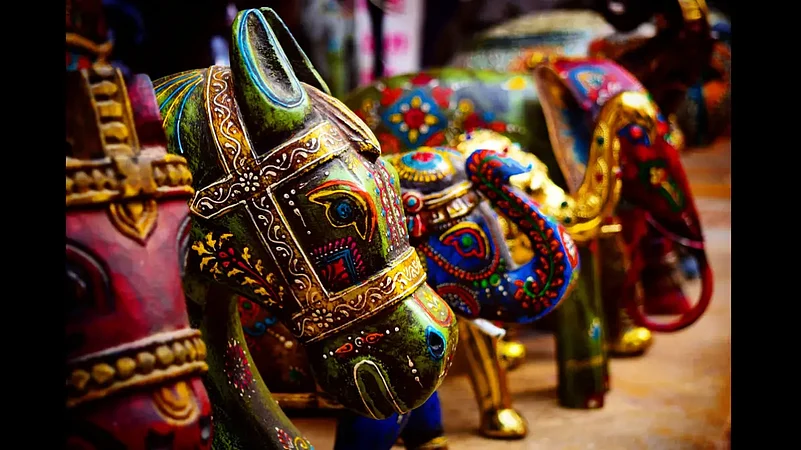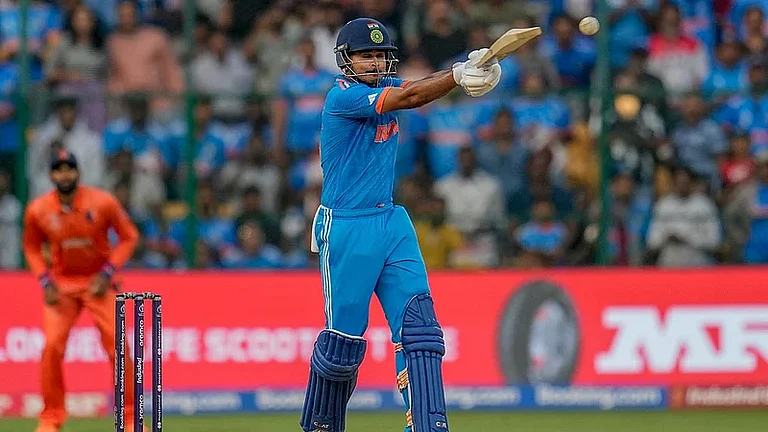The Rajput princes, who were great patrons of art, invited skilled artisans from other parts to settle down in their principalities. This royal patronage was one of the main reasons why the artisans could work with single-minded devotion towards enhancing the quality of their craft. The Rajputs com- missioned goldsmiths, printers and dyers, painters, potters, stone carvers, weavers of cotton and silk to produce works of art for them and rewarded them handsomely when they excelled in their craft. It is a legacy that lives on in Rajasthan. Each region has its own unique crafts, and every little town and village has its share of lanes where craftspersons hold sway. It is this treasure trove that tourists are privileged to discover, be it in a modern shopping centre in a big town or in a traditional bazaar in a small village. Here is part two of craft souvenirs to pick from your Rajasthan trip:
Terracotta Products and Pottery

Each district of Rajasthan has its own distinct style of pottery. Jaipur’s blue pottery is thought to have originated in the first part of the 19th century, and came to India via Persia and Afghanistan. It remained neglected after the end of the Mughal era and was revived because of the efforts of Padma Shri award-winner Kirpal Singh Shekhawat. Blue pottery, made from crushed quartz, is available in various shades of blue. Embellishments of painted motifs in geometrics and nature’s bounty in bright yellows, oranges and green and other colours have further enhanced it. The product line ranges from items like vases, ashtrays to bathroom accessories. In Molela village, near Nathdwara, craftsmen are skilled at making terracotta idols of gods, often depicted riding bulls, horses, boars and dogs. This art form has been passed down from one generation to another. Because of its religious significance the craft is locally known as murtikala.
Roadside vendors sell the idols in Udaipur’s markets but these are also available across the state. Alwar is known for paper-thin pottery known as Kagzi pottery, which is easily distinguishable because of the thin walls of the items. Bikaner’s painted pottery and the terracotta products of the Nohar Centre of Bikaner are equally famous. The city is also known for its gold lacquered pottery, where the patterns are done on a white-chalklike surface. Sawai Madhopur, on the other hand, is a special branch of Rajasthani pottery that is practised on the clay obtained from the nearby Banas river. The slightly greyish colour on the pottery created here is achieved by sealing the vents of the kiln before the firing is completed.
Stone Carving
Gorgeous fretwork, carved deities, elaborate columns, garden ornaments, jaali screens, marble tabletops, lamps and candlestands all bear the fine detailing at which the Rajasthani craftsmen are so skilled. While stone carving is mostly seen in Jaipur, Makrana, Jodhpur and Jaisalmer, stone products are available in other cities as well. As far as engraving goes, for instance, Dungarpur is famous for green stone and Thanagazi for its red stone and lime pieces. From functional domestic items that come in beautiful shapes to elegantly carved pillars and doors ornamented with brass motifs, you can find stone products of every conceivable nature across the state. Kishangarh is the best place to look for marble and stone items such as statues, fountains, table tops and lamp bases. You will find all these and more in the 50-odd shops lining NH-8.
Metalwork

Everything from tabletops to picture frames is available in a range of metals in Rajasthan. Among the brass, iron or silver items that you can pick up are pen cases, styluses and compasses. Jodhpur is known for brass toy items—cannons, elephants, horses and camels—while Jaipur’s speciality is its brassware. Here, there are broadly three styles of engraving—chikan, which refers to floral patterns carried out over a lacquered surface; marori/chrakwan, where elaborate designs are etched on the surface and the space filled with black lac; bichi, on the other hand, refers to finely done flowers and leaves rendered over lacquered surface. Decorative metalwork is created using a range of techniques, from ham- mering, perforation and chasing to repousse and piercing. Koftgari is a unique weapon ornamentation technique, which, like damascening, is an overlay art where the metal surface is cut in a crosshatch pattern using a chirni (a double- edged blade). The patterned depressions are then filled with gold or silver wire and pressed using the hakik stone (agate). Koftgari, which translates to beaten work, first flourished under the Mughals in the 16th century and then won favour among the Rajputs, who considered it important to have weapons and armament ornamented. Practised mainly in Udaipur today, koftgari swords and daggers feature arresting animal head shapes and floral motifs on the hilt ends. Souvenir knives and daggers remain popular, even though craftsmen are taking this special overlay technique to jewellery, vessels and mirror frames, implanting on them styles like the Ganga-Jamuna (featuring both gold and silver) and Hara Sona (using gold-silver alloy), among others.
Weaponry
A tradition of weapon-making that is anything less than magnificent doesn’t befit a land that has a long history of warfare and royalty. The deadly, double-edged swords of Sirohi enjoy worldwide renown, and the credit goes to its lightweight nature. These swords aren’t bad to look at either—with their blued-steel hilts that were later overlaid in gold and carved floral motifs upon. The Sikligars of Udaipur have been the historical keepers of making new swords and maintaining and sharpening old ones. The process of polishing the swords’ blades is an interesting one: rudimentary materials/tools like ash, horseshoe, emery stone are used. The swords are then lowered into an oven and sesame oil applied over them after that. Sword and dagger making is a dying craft, so the Sikligars now make other tools such as scissors.
Woodwork

While one may not traditionally associate a desert land with wood items, Rajasthan has a surprisingly large number of showpieces in wood that are incredibly beautiful. You will find doors and windows with beautiful carvings, beds, divans, chairs and swings in Barmer, Bikaner, Shekhawati and Jodhpur. If you are looking for something that’s smaller in size, there are plenty of options as well. Kavadhs, which are portable wooden shrines that have seven panels and are employed in the oral storytelling tradition of kavad baanchna, are made by the Kumawat artisans of Bassi, near Chittorgarh. This village, famous for puppets, toys and idols (including those of Ishar and Gauri, deities of the Gangaur festival) is also where the famous set of musicians in wood and sindoor boxes shaped like peacocks can be bought. For Painted Wooden Furniture, shops in Jodhpur and Kishangarh are the best op- tions. Other pieces of furniture that make for excellent souvenirs are the jute-and leather- embroidered chairs of Tilonia—a half-hour drive from Kishangarh—and the carved-back, string-bottom chairs of Shekhawati. No discussion on woodcarving in Rajasthan is complete without a mention of the striking, delicate, carved sandalwood creations crafted by the Jangids of Churu. The Jangid family has practised the craft since Mughal rule and has kept the dying art alive.
Paper Crafts
Just 14km from Jaipur’s busy Narayan Singh Circle, Sanganer is known for the diverse range of items made from recycled paper. The Kagzis—the local papermaking community— use three types of raw material to produce paper: cotton rags, silk and banana trunk fibre. The paper is available in sheet form and priced as such but there are also products such as frames, lamps and boxes, and trays and plates, but diaries and greeting cards far outnumber the rest. Bahi work, or the craft of making traditional hardbound accounting diaries with their covers adorned with a characteristic stitched pattern, hails from Udaipur. The cover of the bahi is made from a range of materials, including leather, zari fabric, printed cotton or silk, and is traditionally red, a colour associated with the goddess of wealth. What’s unique about bahis is that they did not need to have tables or columns drawn using ink—the makers would just carefully crimp the pages demarcating the individual areas for entries to be made.
Puppet Making

An integral part of the family of woodcrafts in the state, puppet-making is in its own right a distinctive tradition that goes back ages. Known as kathputlis, easily be one of Rajasthan’s best-known cultural mascots, these string puppets are made from the easily available mango wood, their limbs fashioned from old rags stuffed with more rags and hay. With their animated expressions and bead jewellery, these players of a quirky theatrical tradition make for affordable mementoes, too.
Leather Crafts
Almost every town in Rajasthan has items made of leather on sale. Juttis, in all sizes and colours, are obviously big favourites with tourists. The mojari is to the Rajasthanis what the sombrero is to the Mexicans. The leather (usually camel or goat), softer on the top over the toes and the thick sole shield the wearer from the intense desert heat. The royals loved their mojaris embellished with precious stones and gems, but with time, the masses began taking to them, and more affordable adornments such as cowrie shells, beads, mirrors and the like came in. Bikaner’s world-famous Gesso (Usta/ Naqqashi) work can be found in a delightful range of containers. The traditional centres where leather products are sold include Bikaner, Jaipur, Jodhpur and Jaisalmer. You will also get good deals at Ajmer, Bharatpur, Sikar and Sawai Madhopur.


























